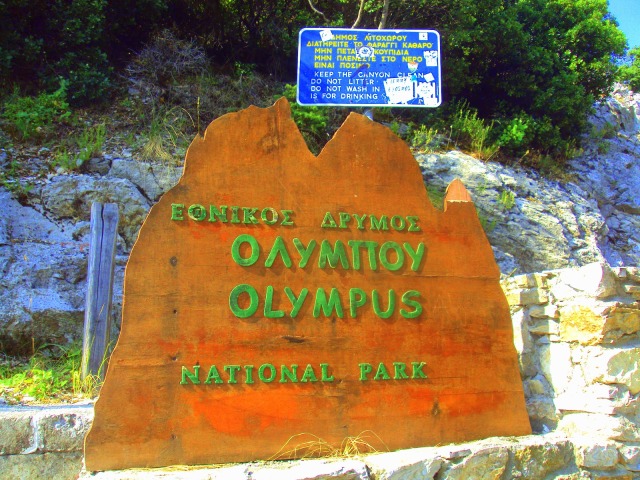 |
| The entry to the park! |
When Boris & I started planning our trip in Greece, we had this great idea: why not hike Mt. Olympus!? Yes! I thought, totally sure this would be excellent. After doing minimal research and reading a few Lonely Planet forums, I discovered that Mt. Olympus is a relatively doable hike because it’s not a technical climb. The very top summit, which is where far fewer travelers reach, is a Class 4 scramble, which basically just means you’ll use your hands to help you climb but you don’t really need climbing tools (when there’s not snow, at least).
I continued my research, and found a few personal accounts on blogs and the like. These brave souls had summited and lived to tell the tale, all of whom seemed to endorse the experience as being a strenuous but fun hike up a mountain. What I neglected to realize was the reality of where they started their trip.
You see, there are a number of ways to arrive at the top of Mt. Olympus. Seemingly the most popular is to start at the trailhead in Prionia and hike the 2.5-3 hours to Refuge A, spend the night there in the mountain, and summit the following day. Cool, right? So, we made reservations for a hotel in Litochoro, the town at the foot of Mt. Olympus, for one night, with the intention of hiking to Refuge A from there and summiting the next day.
The catch: Prionia is halfway up the mountain. This was a detail I kind of neglected, forgot about, whatever. I was just so excited that we were hiking Mt. Olympus! As a student (and teacher) of the classics, and a lifelong lover of Greek mythology, the idea of hanging out where Zeus supposedly lived was an exciting one.
Fast forward to Sunday, when we arrived in Litochoro. After a long conversation with our extremely helpful hotel manager, we garnered the following information:
1. It was going to be about 100 on the day we decided to hike.
2. Prionia is a four to five hour hike from Litochoro.
3. From Prionia to Refuge A, it’s about another 2.5-3 hours (Keep in mind that this would have been after very strenuous uphill climbing for five hours).
Truth be told, I was concerned after this discussion. If we were willing to taxi up to Prionia, it would have been no problem, but summiting from half-way up the mountain? We wanted to do the whole shebang.
So, we adapted, as travel tends to require. We discovered that our (incredible) hotel had availability for the following night, and decided we would take the trek from Litochoro—the path started just up the street from our hotel—to wherever we could get; Prionia was a goal, or a monastery right below it. We were warned about the heat, and had to accept the realistic parameters of the climb to be safe.
Since we had less of a concrete goal, we got a late start; breakfast at 8, finally made it to the trail head with enough water and some snacks around 9:45. The first hour was BRUTAL. Honestly, I’m not a huge hiker. I like to hike. I go on hikes once every couple months, probably. I’m in pretty good shape. But never in my life have I strapped a pack on my back and made it up huge mountains or bushwhacked through the wilderness. I leave that to my more daring and outdoorsy friends, of which I have many. But that was why Olympus was appealing to me, in part: I could do it.
In that first hour, though, where the elevation rises so rapidly, and all you’re seeing is stairs and switchbacks and feeling your heart racing and the mid-morning heat is rising, you can get pretty discouraged. And so we were after the first hour. Our pace was slow, mostly because I was keeping it that way. We had been told that water from the river was potable, so we only brought a couple big liters of water and had already made it through one with no clue as to when the river would cross with the path. Luckily, we ran into some Greek trailrunners, who reassured us that we were only about 20 minutes away from the first river connection.
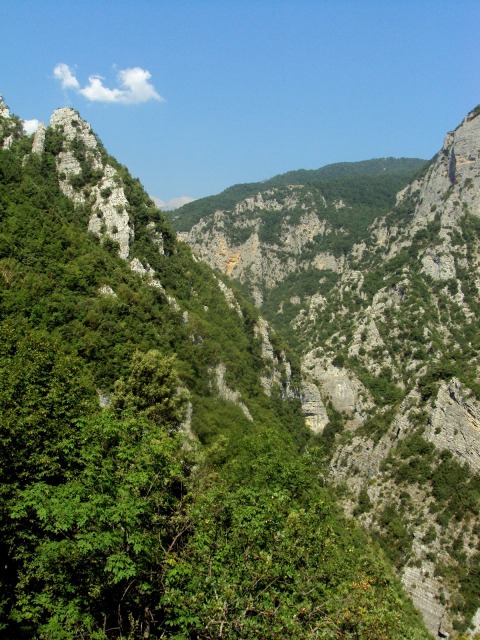 |
| One of the first big views |
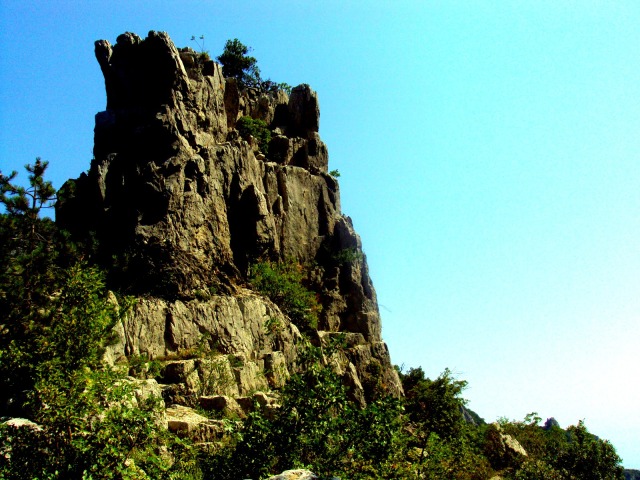 |
| Sweet rocks |
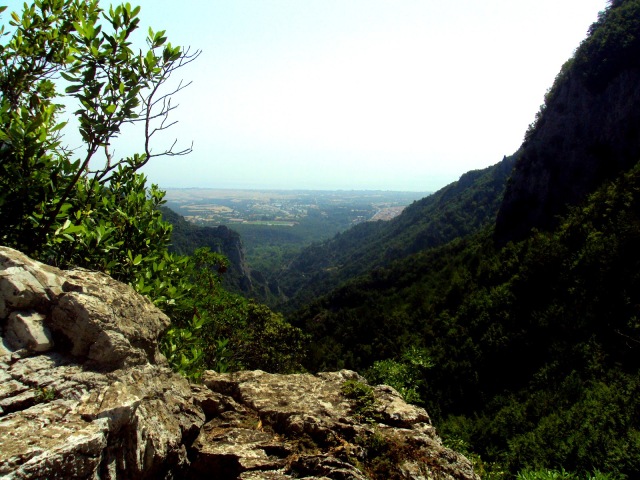 |
| Another pretty stunning view |
The water was completely rejuvenating. Crystal clear and icy, it ran along the trail for a while and we took a little dip. Refreshed, with full bottles of water, we continued on our way.
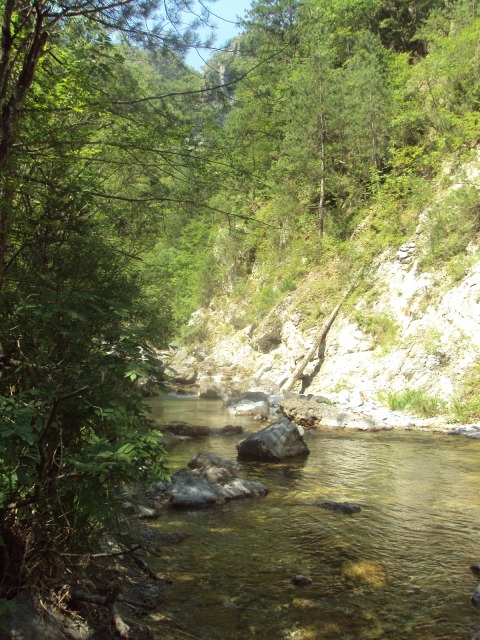 |
| The waters of Olympus |
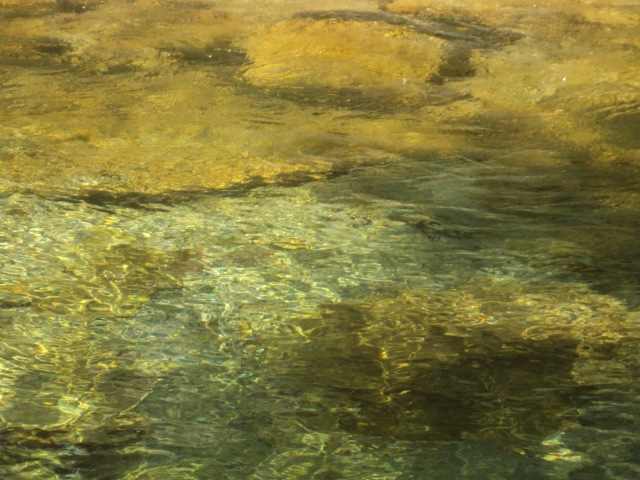 |
| See how clear it is! Potable, clear mountain spring water. |
Due to the heat, we tried to take things slow. At first I had been really upset when we decided it would probably be safer and more comfortable not to summit, but my boyfriend was right: it felt a lot different once I was on the mountain. The views were spectacular. Luscious trees filling up the canyon opened onto Litochoro on one side, on the other were the peaks of Olympus, daring us to conquer them.
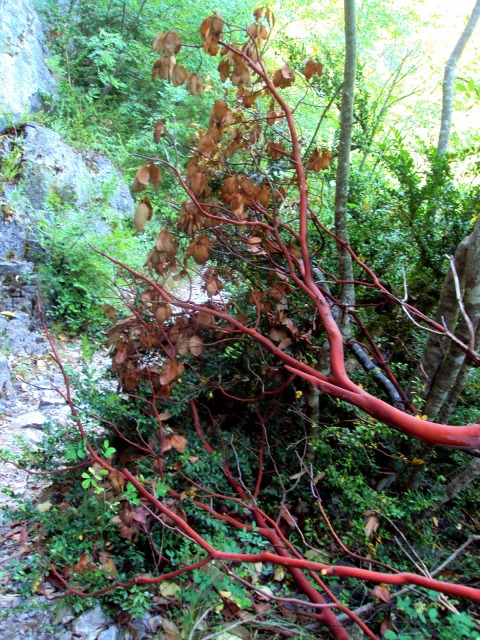 |
| I’d love to know what species of tree this is. We saw a number of fallen red ones exactly like this. At first we thought it was spray-painted, that was how red it was! |
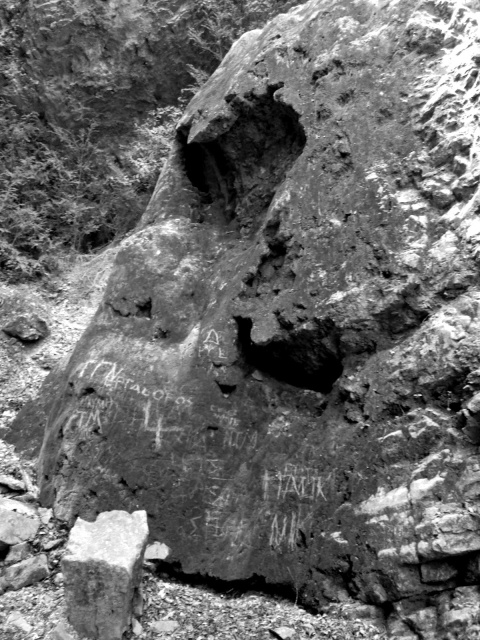 |
| History chronicled in the names of the hikers. |
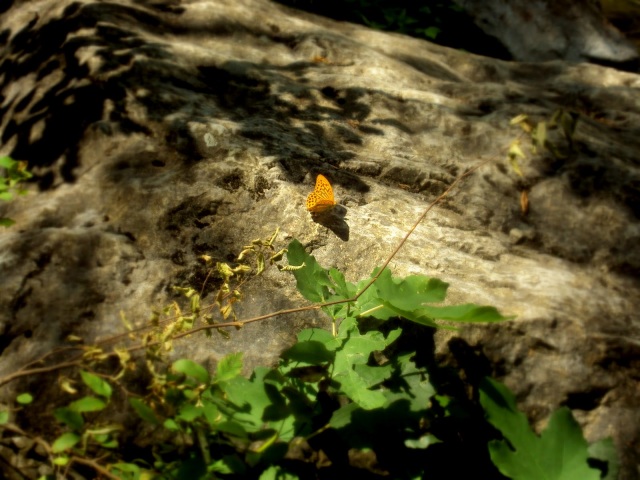 |
| Wildlife! There were SO many butterflies all over the place! |
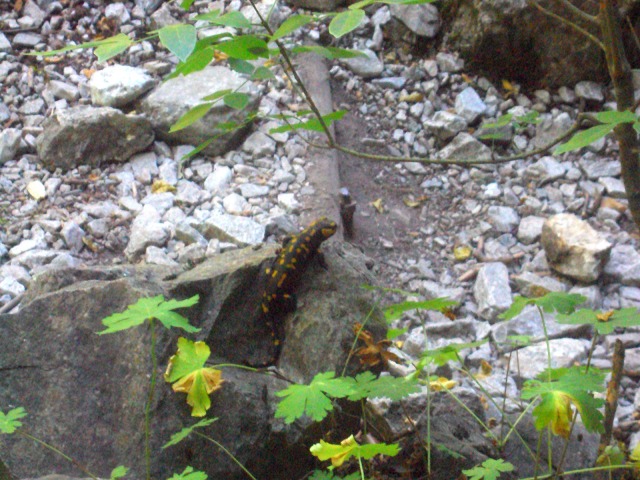 |
| More wildlife! This gecko surprised us with its a) presence and b) vibrant colors! |
After about 5 hours of hiking, including breaks, we made it up to a monastery that had been destroyed in World War II, completely bombed by the Germans in 1943. Now it is being rebuilt, slowly but surely. The outer buildings are still ruins, ruined enough that someone who hadn’t read the signage would assume it had just been left to rot for some reason or another. But once you enter the inner courtyard, you will find something else.
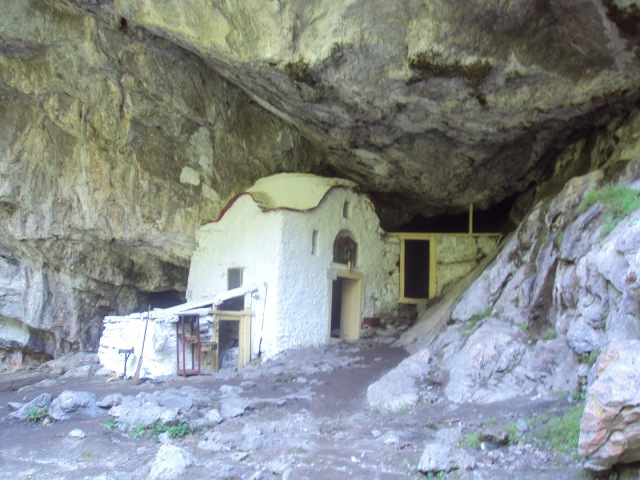 |
| A small structure where holy water runs, about a 30 minute walk from the monastery. |
We found a number of other tourists who had driven up from Litochoro or down from Prionia (only about another hour on foot), workmen laboring over the renovations, and a quiet, young monk clad all in black who offered us the best Turkish delight I’ve ever tasted. He brought out the bowl of sweets and offered it to everyone sitting there before asking us where we were from. The family sitting by us, what looked to be a grandmother, perhaps two adult daughters, a husband, a grand-daughter, also shared their food with us. Our stash of raisins and walnuts essentially depleted, we accepted their generous offerings of fresh cucumber, apricots and bread without much protest and with many thanks.
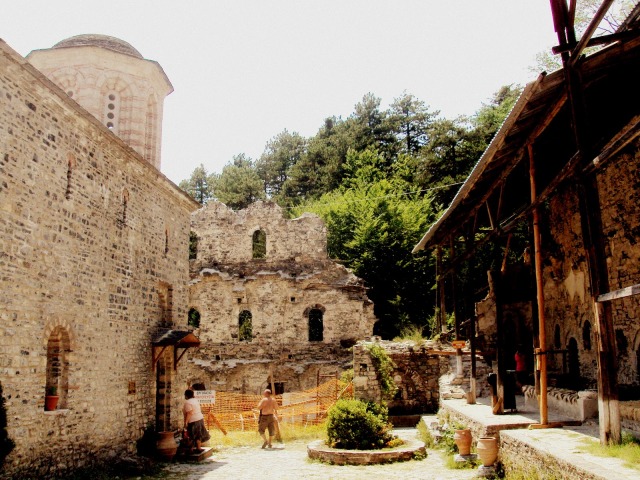 |
| The inner part of the monastery of Agios Dyonisios. To the right was where we were welcomed and fed. |
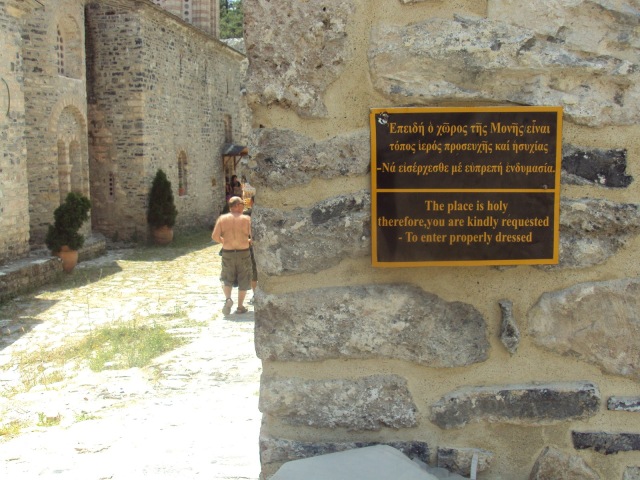 |
| Funny shot of the day: the sign requests for people to enter properly dressed, as the area is sacred. Notice the half-naked man on the left entering said sacred space. |
As we rested for those thirty minutes, we considered our strength, and the circumstances of our ascent. Had we needed to continue on to Prionia, rest there, and then hike another few hours to Refuge A, we could have. It would have been difficult, we would have arrived late, but we could have done it, and summited the following day. Knowing that makes me feel a little bit better, I suppose: that we could have. We will someday, maybe after training a bit more and being more organized. We’d need to leave much earlier and pack better. And we probably wouldn’t want to hike it in July—with temperatures reaching 100 degrees, and the tree line disappearing as one reaches the summit, any hiker would face the dangers of heat exhaustion or heat stroke, neither of which is safe. May and September are the recommended months for such a climb.
Our return to Litochoro took about three hours, and ultimately we hiked about 10 miles up and down from Litochoro to the monastery of Agios Dionysios. By the end, we were both beat; steep uphill and downhill walking is tough on a lot of different muscles and joints, and as we reached the entry to the park, we were both glad we had finished. We rewarded our hard efforts with a celebratory dinner and a relaxing evening in.
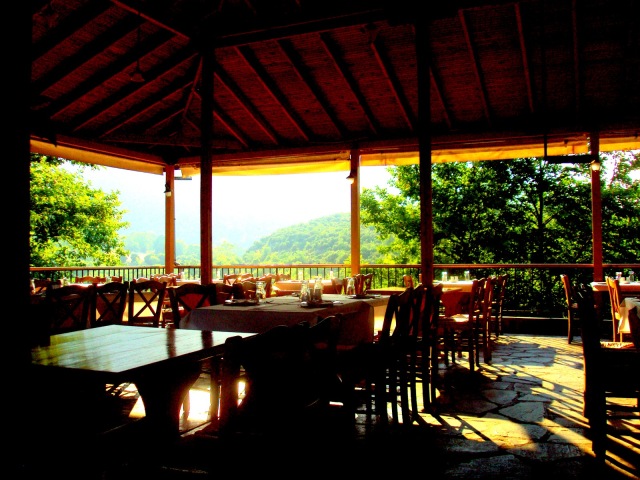 |
| We ate dinner at like 7 p.m. which is very early for Greeks, so we were two of five people eating. |

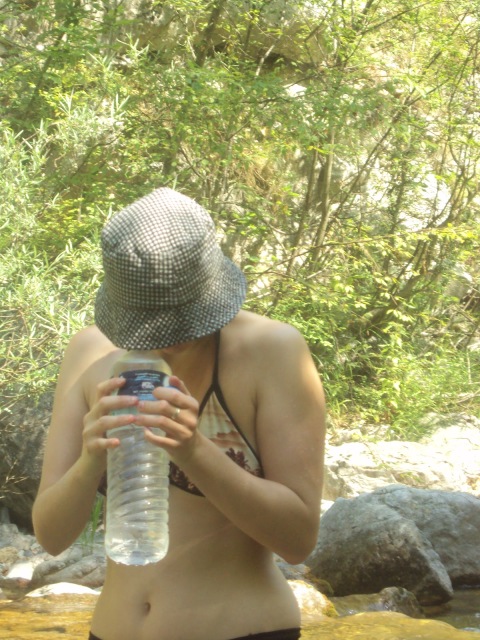
BAD ASS.Omg. This is one of my favorite posts yet!!! The photographs are wonderful; and the one of you looking in the waterbottle CRACKS ME UP.
So glad you like it! I had fun writing it, as well as living it! 😉
Go Ms. Button! I want to do the summit hike with you. I'm thinking it would be a good pre-30 goal (for you, not me, I'm too close!).
Heck, no, you could totally do it pre-30! It's really just a matter of training on Mount Lemmon, honestly, since they're comparably sized. And maybe lots of stairs. 😉